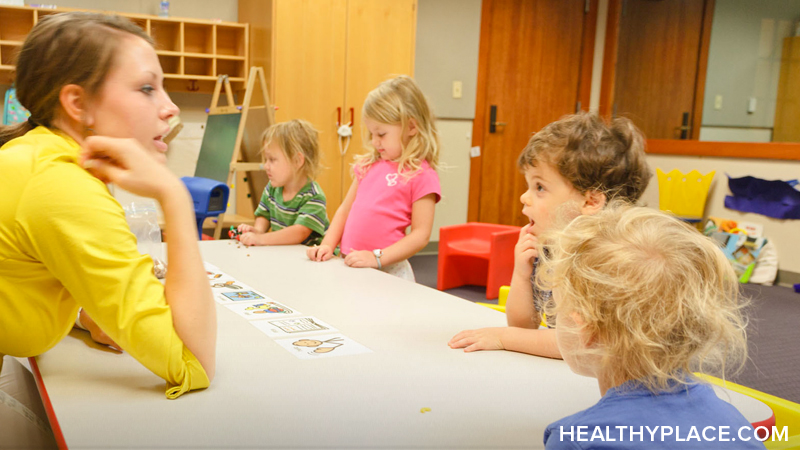Are There Downsides to Participating in Child Therapy Groups?

For many kids, child therapy groups are helpful. When child psychology researchers analyzed 56 studies about the effectiveness of group therapy in children and teens, they discovered that children and adolescents who participated in child therapy groups did better at the end of treatment than 73% percent of those that didn’t receive group therapy (Hoag & Burlingame, 2009).
Group therapy can be effective for a lot of kids and teens because it meets them where they are. Children have limited capacity to understand and talk about emotions. Teens naturally turn to peers more than they do adults. Guided interactions with peers, social skills building, and immediate peer feedback about how a participant’s behavior and emotions affect others are all aspects of adolescent and child therapy groups that make them successful.
Group therapy involves approximately six or eight members (sometimes more) meeting together with one or two therapists to work collectively to overcome a specific problem or learn new life skills. Members are screened for readiness and fit in a group. Groups can meet for varying amounts of time, and sessions typically last between six and 12 weeks. Adolescent and child therapy groups are comprised of children of approximately the same age, so peer interaction is natural and helpful.
Let’s look at what group therapy has to offer kids and teens as well as the downsides to participating in child therapy groups.
Purpose of Child Therapy Groups
The general goals of group therapy for children and adolescents are to
- Give participants a chance to communicate and be heard by peers
- Help them learn listening skills
- Provide opportunities to be respected and to give respect
Counseling groups can accomplish what individual therapy cannot. They can replicate difficulties faced in large group settings like classrooms, the playground, and activities. Group members participate in activities with each other that help them learn how to navigate group settings in their lives.
Each child therapy group has a unique purpose. They might center around specific problems like anxiety (including social anxiety), depression, eating disorders, grief and loss, bullying, or myriad other mental health concerns. Some groups are designed for skills improvement, addressing social skills, problem-solving strategies, skills needed for emotional regulation, or self-esteem-building skills.
When kids and teens can interact with each other and a group therapist to address these issues and more, they can reap numerous benefits.
How Child Therapy Groups Benefit Kids, Teens
Adolescents who participate in child therapy groups gain many age-appropriate improvements to help them navigate middle- and high school. Among them are
- Self-confidence, including confidence in social settings
- A sense of validation—other teens understand and share similar struggles
- Knowing that they’re not alone, that they have support from group members
- Improved communication skills
- Improved relationships with family, teachers, and, especially, peers
- Better coping skills for frustrations and problems, including handling and reducing stress
Children’s groups are often play therapy groups. Through play and in interacting with other children, participants enhance self-awareness, self-regulation, and empathy. Children’s play therapy groups decrease behavior problems by teaching important social skills through games and other interactive activities.
Adolescents and children can gain much from group counseling. However, this type of therapy is not for everyone. It has drawbacks that might outweigh the benefits for some children.
The Downsides to Participating in Child Therapy Groups
Treatment in group settings doesn’t work for all kids and teens. In some situations, the risk of harm to an individual and to all group members is greater than the potential benefits. For example, youth in crisis or who are suicidal should be counseled individually rather than in a group setting. Children or adolescents with extreme social anxiety would only have that anxiety exacerbated if they had to participate in group counseling.
Other disadvantages to group counseling for youth include:
- Personality clashes that detract from the forward movement of the whole group
- Unwanted and unkind comments from group members to each other
- Frustrations caused by participants interrupting each other or not taking activities seriously
- Trust/mistrust problems can make group members afraid to speak honestly
- Potential breaks in confidentiality (comments are supposed to stay in the group, but there isn’t a guarantee that members won’t talk about each other outside the group)
Child therapy groups can be positive, helpful experiences for a lot of kids and teens. Despite the benefits, counseling groups have risks. It’s important to carefully consider potential downsides before enrolling your child or teen in a group therapy program.
See Also:
APA Reference
Peterson, T.
(2022, January 11). Are There Downsides to Participating in Child Therapy Groups?, HealthyPlace. Retrieved
on 2026, January 8 from https://www.healthyplace.com/parenting/child-therapy/are-there-downsides-to-participating-in-child-therapy-groups



